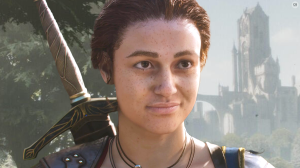For the better part of the last decade, I have been dying for a sequel to Super Mario Odyssey. The 2017 3D Mario platformer isn’t just my favorite Super Mario game of all-time, but it’s also my favorite title to release on Switch throughout the console’s life. Despite this adoration, Nintendo has been content with putting Mario on the back burner in recent years, so much so that a new 3D Mario game still doesn’t seem to be on the horizon. Fortunately, that doesn’t mean that much of what made Super Mario Odyssey fantastic is nowhere to be found, as Nintendo has chosen to expand on many of the ideas from that game in the stellar Donkey Kong Bananza.
Videos by ComicBook.com
To be clear, Donkey Kong Bananza is not a proper sequel to Super Mario Odyssey, but the connective tissue between the two games is apparent almost immediately. Bananza centers around Nintendo’s famous ape as he goes on a journey to the center of the world alongside his companion, a young version of Pauline. This adventure sees DK and Pauline traverse through a variety of levels that make up the inner workings planet, all of which are filled with “Banandium Gems”. Hunting down these glowing banana-like objects is what you’ll spend the vast majority of your time doing in Donkey Kong Bananza, but the game excellently ensures that this straightforward task never becomes a boring one.
The key manner in which Donkey Kong Bananza finds a way to keep your attention from beginning to end is by way of its destructible, malleable world. Donkey Kong possesses the power to pound with his fists through just about everything you can find in Bananza. From the floor beneath DK’s feet to a mountain you can see on the horizon, Bananza features a world that can be explored in near-limitless ways as you can make your own paths at any single time. Not only is this type of freedom something that I’ve never seen before in a platformer, but it ends up making the experience constantly engaging.
Bananza chooses to lean into this format further by scattering bananas anywhere and everywhere across its massive levels. Some of the bananas are rather easy to snag, while others require much more digging and ingenuity to obtain. Bananza also has a variety of challenge stages, which whisk DK and Pauline away to various areas where they have to beat certain enemies or solve specific puzzles to get every banana. Some of these levels end up being the most enjoyable in Bananza, primarily as they tap into nostalgic elements of older Donkey Kong games.

DK also consistently acquires new power-ups throughout Bananza, which goes a long way in making the game never feel stale. These upgrades allow DK to transform into different animals, like the Ostrich, which briefly gives him the ability to fly. Other transformations allow DK to traverse across environments he normally wouldn’t be able to, or punch through blocks that he can’t in his base form. All of these upgrades to Donkey Kong help further the core ideas of creativity and experimentation at the core of Bananza and let you rethink the way you approach certain situations that you’ll run into.
When you’re not obsessively trying to find every banana within Donkey Kong Bananza, there are plenty of bosses and enemies to wallop on as well. For the most part, I found boss fights in Bananza to be a bit too easy at times. This isn’t true of every battle, but many of the bouts that serve as endcaps to the various levels within the game end up being a bit anticlimactic rather than high points that you’ll think back on fondly.
Speaking of downsides with Bananza, the camera is often a mess. Since Donkey Kong can dig his way through just about any environment in the game, the camera struggles to keep the focus on DK, especially in tighter spaces. It’s a problem that I think Nintendo did its best to find a solution to, but it’s still hard not to consistently get agitated when you’re trying to create your own monkey-made tunnel in the side of a mountain and can’t see what you’re doing.

Beyond the gameplay experience that it offers, Donkey Kong Bananza actually ends up featuring a pretty compelling story. Much of this narrative thrust is thanks to the mysteries surrounding Pauline and her backstory, but there’s enough meat on the bone, especially for a Nintendo game, that makes you want to keep pushing through to see the next beat.
More than anything else, though, what surprised me most about Donkey Kong Bananza is how it honors everything that came before. This could have been an easy moment for Nintendo to reboot Donkey Kong entirely, and in some ways, Bananza is that. But it’s also a love letter to DK’s history, beginning not only with the classic Donkey Kong arcade game, but also the Donkey Kong Country series and Donkey Kong 64. There are so many surprises and subtle callbacks to older Donkey Kong games scattered all throughout Bananza, many of which I did not expect to see. If you’re a fan of every Donkey Kong game that came before Bananza, there is so much to discover that will fill you with joy, same as it did for myself.
Donkey Kong Bananza is, without question, one of my favorite Nintendo games of the past decade. Not only does it serve as a fantastic new entry in one of Nintendo’s oldest franchises, but it’s the best reason so far to go and pick up a Switch 2. While I thought I wanted a sequel to Super Mario Odyssey for the past eight years, I’ve instead found myself far more thrilled by what Nintendo has done with Bananza.
Score: 4.5/5
Donkey Kong Bananza releases later this week on July 17th for Nintendo Switch 2. An advance copy of the game was provided by the publisher for the purpose of this review.








